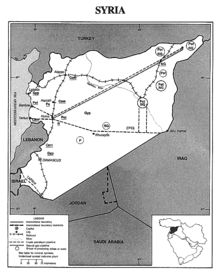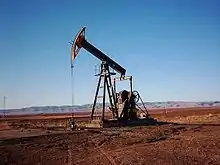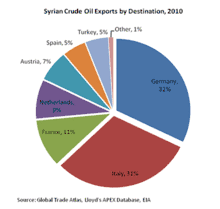Petroleum industry in Syria
The petroleum industry in Syria forms a major part of the economy of Syria. According to the International Monetary Fund, before the Syrian Civil War, oil sales for 2010 were projected to generate $3.2 billion for the Syrian government and accounted for 25.1% of the state's revenue.[1]
Syria is a relatively small oil producer, that accounted for just 0.5% of the global production in 2010,[2][3] falling to less than 0.05% by 2016.[4] Although Syria is not a major oil exporter by Middle Eastern standards, oil is a major component of the Syrian economy, because of Syria's extremely low GDP per capita. Syria's oil sector has been hit by the Civil War and international sanctions imposed on Syria.
Syria's two biggest oil companies are the Syrian Petroleum Company (SPC), which is owned by the Syrian Ministry of Petroleum and Mineral Resources, and Al-Furat Petroleum Company which is 50% owned by General Petroleum Corporation and the other 50% are foreign owned. The joint venture of AFPC currently includes General Petroleum Corporation with 50%, Syria Shell Petroleum Development with 32%, and the remainder held by Deminex, which is owned by Himalaya Energy Syria, a consortium of China National Petroleum Company and India's Oil and Natural Gas Corporation.[5] As of December 2011 Shell has suspended operations in Syria due to EU sanctions.[6] Another important consortium is Deir Ez Zor Petroleum Company, owned by SPC and France's Total. Total suspended operations in the country from December 2011.[7] A more recent entrant is the United Kingdom's Gulfsands Petroleum. As of February 2012, Gulfsands has suspended its Syrian operations due to EU sanctions.[8]
Geography

Syria is the only significant crude oil producing country in the Eastern Mediterranean region, which includes Jordan, Lebanon, Israel and the Palestinian territories. According to the Oil and Gas Journal, Syria had 2,500,000,000 barrels (400,000,000 m3) of petroleum reserves as of 1 January 2010.[5] Syria's known oil reserves are mainly in the eastern part of the country in the Deir ez-Zor Governorate near its border with Iraq and along the Euphrates River, and a number of smaller fields are located in the center of the country.[9] In 2010, Syria produced around 385,000 barrels (61,200 m3) per day of crude oil.[1][3] Oil production has stabilized after falling for a number of years, and is poised to turn around as new fields come online. In 2008, Syria produced 5.3 billion cubic metres (1.9×1011 cu ft) of natural gas, and two years later in 2010, it increased production to 7.8×109 m3 (2.8×1011 cu ft).[10] While much of its oil is exported to Europe, Syria's natural gas is used in reinjection for enhanced oil recovery and for domestic electricity generation.[5]
Although Syria produces relatively modest quantities of oil and gas, its location is strategic in terms of regional security and prospective energy transit routes.[5] The first section of the Arab Gas Pipeline to enter Syria, totalling 600 kilometres (370 mi) through Syria, starts at the Jordan–Syria border in the south, connecting to Tishreen and Deir Ali power stations.[11] This was subsequently extended to connect to Deir Ammar power station in Lebanon and Baniyas in Syria.[12] A further section was planned to continue up to the Turkish border,[11] but the ongoing civil war is expected to further delay this connection.[13]
History

Syrian oil exploration first began in 1933 during the French Mandate by the Iraq Petroleum Company (a consortium made up of Shell, BP, Exxon-Mobil, Total, and Gulbekian), which after unsuccessfully drilling eleven wells, gave up hope of finding any oil in Syria. In 1949, James W. Menhall (1881-1974), an independent oil producer from Illinois, United States, was approached by Syrian President Shukri al-Quwatli to come to Syria to prospect for oil. His James W. Menhall Drilling Company was awarded a concession on 17 May 1955 by unanimous vote of the Syrian parliament and started drilling in April 1956. In September 1956, Menhall discovered the Karatchok oil field with over 1 billion barrels of reserves. Six consecutive wells were drilled, each producing in excess of 4,000 barrels (640 m3). Menhall was just commencing preparations to drill the adjoining Rumeilan oil field (with over 500 million barrels of reserves) when, on 5 October 1958, President Gamal Abdel Nasser of Egypt, as President of the United Arab Republic, expropriated Menhall's concession and confiscated his equipment and three drilling rigs without compensation. The Syrian government, under the Baath Party leadership, has since refused to consider any compensation. The Syrian oil industry took off in 1968, when the Karatchok oil field began production after a pipeline connecting it to the Homs refinery was completed, although Syria did not begin exporting oil until the mid-1980s.[14]
In 2009, Syria's net petroleum exports were estimated to be 148,000 bbl/d (23,500 m3/d).[15] All oil exports are marketed by Sytrol, Syria's state oil marketing firm, which sells most of its volume under 12-month contracts. Before the imposition of EU sanctions, Syrian crude oil exports went mostly to the European Union, in particular Germany, Italy, and France, totaling an estimated 137,400 bbl/d (21,840 m3/d) in 2009, according to Eurostat.[16] In 2010, the European Union as a whole spent $4.1 billion on Syrian oil imports.[17]
Oil production during the Syrian Civil War
The Syrian Civil War broke out in 2011 and is ongoing. In the same year, Syria's major trading partners imposed international sanctions on Syrian oil and financial system, devastating the Syrian oil industry, adding to the devastation of the civil war.[18] Local exporters of oil in Syria include the Altoun Group in Maaraba, Rif Dimashq, Syria,[19] formed in 1968,[20] which it is owned by Salim Altoun, has been on an EU sanctions list since May 2012.[21]
During the civil war, the self-declared state of Islamic State of Iraq and the Levant (ISIL/ISIS) controlled most oil fields in eastern Syria starting from 2013, in which they smuggled the oil located in Deir ez-Zor province outside Syria by producing 34,000–40,000 barrels per day (bpd). Quality of Petroleum determined price of each barrel sold at the wellhead 25 to 45 dollars.[22]
Following the American control of eastern Syria, American President Donald Trump claimed on 28 October 2019 that $45 million a month could be earned from the Syrian oil.[23] In November 2019, Syrian President Bashar al-Assad indicated that ISIS terrorists have two partners in stealing the Syrian oil since 2014, Recep Tayyip Erdoğan and his coterie, and the Americans who always try to loot the other countries.[24]
However, Syria produced 406,000 barrels per day (bpd) in 2008, but the oil production dropped to 353,000 bdp in 2011 and had plunged to just 24,000 bdp by 2018, a reduction of more than 90%,[18] according to British Petroleum Statistical Review of World Energy.[25]
In January 2020, the militants sent divers to plant explosives on the underwater pipelines at an oil facility of Syria. On January 27, the bombs exploded off the Mediterranean coast, leaving the Baniyas oil refinery damaged. The facility at the time was recorded to have capacity to process over 13,000 barrels of crude oil per day.[26]
Challenges

Besides the Civil War and the imposition of international sanctions, Syria's oil sector faces a number of challenges, including a decline in output and production resulting from technological problems and a depletion of oil reserves. Syria's rate of oil production has decreased steadily from a peak of close to 610,000 bbl/d (97,000 m3/d) in 1995 down to approximately 385,000 bbl/d (61,200 m3/d) in 2010. Meanwhile, consumption is rising, which means that Syria could become a net oil importer within a decade.[3][14] To counteract this problem, Syria intensified oil exploration efforts.
Syria's upstream oil production and development has traditionally been the mandate of the Syrian Petroleum Company (SPC), owned by the Syrian Ministry of Petroleum and Mineral Resources. SPC has undertaken efforts to reverse the trend toward declining oil production and exports by increasing oil exploration and production in partnership with foreign oil companies. The SPC directly controls about half of the country's oil production and takes a 50% stake in development work with foreign partners.[5]
Foreign investment is vital for improving production levels; however, following the outbreak of the Syrian Civil War, many countries important to Syria's oil exports have imposed sanctions, which legally prevents Western companies from working in the country.
Al-Furat Petroleum Company is a joint venture established in 1985. It is currently 50% owned by SPC and the other 50% is foreign owned: Anglo-Dutch Shell with 32%, and the remainder held by Himalaya Energy Syria, a consortium of China National Petroleum Company and India's Oil and Natural Gas Corporation.[5] The company produced an average 100,000 bbl/d (16,000 m3/d). As of December 2011 Shell has suspended operations in Syria due to EU sanctions.[6]
Deir Ez Zor Petroleum Company is a consortium owned by SPC and France's Total. Total formed its Syrian operation in 1988 and in 2008 renewed its partnership sharing agreement with Syria. Prior to the Syrian Civil War, the company produced an average 27,000 bbl/d (4,300 m3/d) from its fields around Deir ez-Zour.[27]
A more recent entrant is the United Kingdom's Gulfsands Petroleum. At the beginning of 2011, its oil fields produced 20,700 bbl/d (3,290 m3/d).[28] As of February 2012, Gulfsands has suspended its Syrian operations due to EU sanctions.[8] Gulfsands dealings in Syria were also hit by EU sanctions due to Syrian tycoon Rami Makhlouf, a cousin of the Syrian president, holding 5.7% of the company,[29] with this stake being suspended in August 2011 due to specific sanctions relating to Makhlouf.[30] Other international players include or included: Canada's Suncor, Poland's Kulczyk, US-Egyptian firm IPR, Croatia's INA, Russia's Stroytransgas and Soyuzneftegaz, and Triton Singapore.[9][31]
Another option to handle the increase in domestic oil consumption besides increasing oil production is to switch power stations from oil-fired to natural gas-fired. Proven natural gas reserves, approximately three-quarters of which are owned by the Syrian Petroleum Company, were estimated at 2.6 trillion cubic meters (9.1 trillion cubic feet) in 2010.[10] A major challenge for the natural gas industry is logistics: reserves are located mainly in northeastern Syria, whereas the population is concentrated in the west and south.[32]
References
- IMF Country Report No. 10/86 (PDF). March 2010. p. 17. Retrieved 18 August 2011.
- Fineren, Daniel (14 August 2011). "Factbox: Syria's energy sector". Reuters. Retrieved 18 August 2011.
- "BP Statistical Review of World Energy June 2011" (PDF). British Petroleum. pp. 6-8. Archived from the original (PDF) on 15 June 2011. Retrieved 18 August 2011.
- https://www.bp.com/content/dam/bp/en/corporate/pdf/energy-economics/statistical-review-2017/bp-statistical-review-of-world-energy-2017-full-report.pdf
- "Country Analysis Brief: Syria". US Energy Information Agency. Retrieved 18 August 2011.
- "Shell to quit Syria after EU extends sanctions". Financial Times. 2 December 2011. Retrieved 29 August 2012.
- "Total: To Stop Operations With General Petroleum Corp Of Syria". Wall Street Journal. 5 December 2011. Retrieved 29 August 2012.
- "Block 26, Syria". Gulfsands Petroleum. Archived from the original on 12 September 2012. Retrieved 28 August 2012.
- The Report: Syria 2011. Oxford Business Group. 2011. p. 96. ISBN 978-1-907065-34-7.
- "BP Statistical Review of World Energy June 2011" (PDF). British Petroleum. pp. 22. Retrieved 18 August 2011.
- Xinhua News Agency (18 February 2008). "Syria Completes First Stage of Arab Gas Pipeline". Downstream Today. Retrieved 15 December 2015.
- "Lebanon Receives Egypt Gas To Run Power Plant". Downstream Today. McClatchy-Tribune Information Services. 20 October 2009. Retrieved 15 December 2015.
- Rzaveya, Gulmira (February 2014). Natural Gas in the Turkish Domestic Energy Market: Policies and Challenges (PDF). pp. 38–39.
- "Background Note: Syria". US State Department. Retrieved 18 August 2011.
- Taib, Mowafa. "2009 Minerals Yearbook: Syria" (PDF). US Geological Survey. Retrieved 23 August 2011.
- "Imports (by country of origin) - oil - annual data". Eurostat. Retrieved 23 August 2011.
- "Registration of Crude Oil Imports and Deliveries in the European Union 2010" (PDF). European Commission Directorate-General for Energy. Retrieved 21 August 2011.
- "Syria war: Who benefits from its oil production?". BBC. 21 November 2019.
- Canada Tightens Sanctions Against Assad Regime. International.gc.ca.
- "Altoun Group - Company Profile". EC21, Global B2B Marketplace - Connecting Global Buyers with Manufacturers, Suppliers, Exporters worldwide.
- Eriksson, Leif (May 15, 2012). "Syria: Salim Altoun and the Altoun Group added to the EU sanction list".
- Solomon, Erika; Chazan, Guy; Jones, Sam (14 October 2015). "Jihadis' oil operation forces even their enemies to trade with them". Financial Times. Retrieved 28 December 2015.
- "Remarks by President Trump at the International Association of Chiefs of Police Annual Conference and Exposition, Chicago, IL". The White House. 28 October 2019.
- "President al-Assad in an interview with Russian RT-UK TV Channel: In spite of all aggression, majority of Syrian people support their Government, Russia helps Syria as terrorism and its ideology have no borders". SANA. 11 November 2019.
- "BP Statistical Review of World Energy" (PDF). British Petroleum. 2019.
- "Underwater bombs damage Syria's offshore oil facilities". Archyde. Retrieved 27 January 2020.
- Syria, 2010. London: Oxford Business Group. 2010. p. 103. ISBN 978-1-907065-16-3.
- Gulfsands Petroleum Annual Report 2010 (PDF). p. 18. Archived from the original (PDF) on 13 August 2011. Retrieved 21 August 2011.
- Young, Sarah (19 August 2011). "Gulfsands faces risk of extra EU sanctions on Syria". Reuters. Retrieved 21 August 2011.
- Mason, Rowena (24 August 2011). "Syria: Gulfsands Petroleum suspends shares belonging to president Bashar al-Assad's cousin". The Daily Telegraph. Retrieved 28 August 2012.
- "Russia launches into oil exploration in Syria (in French)". Le Monde. 2013-12-25. Retrieved 2013-12-27.
- Syria country profile, pp. 10-11.
Works cited
- Syria country study. Library of Congress Federal Research Division (April 2005).
 This article incorporates text from this source, which is in the public domain.
This article incorporates text from this source, which is in the public domain.
